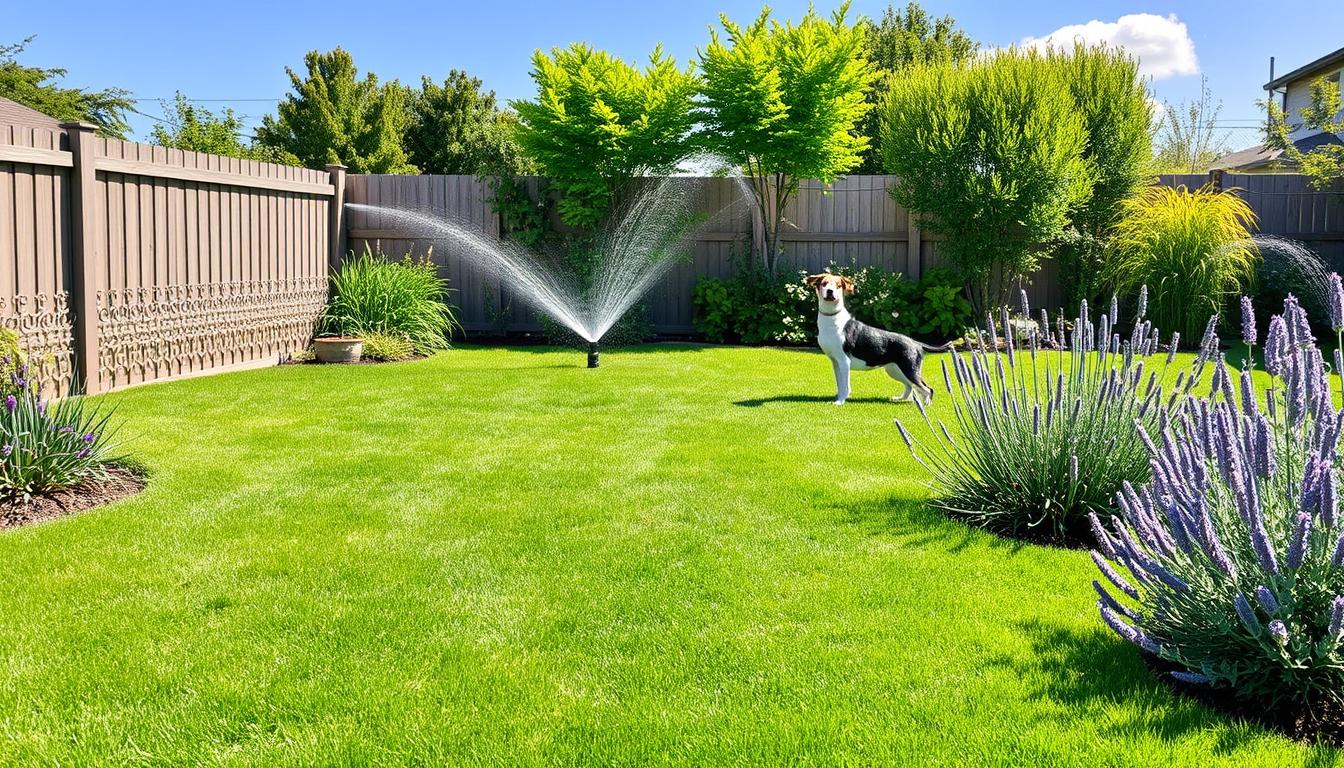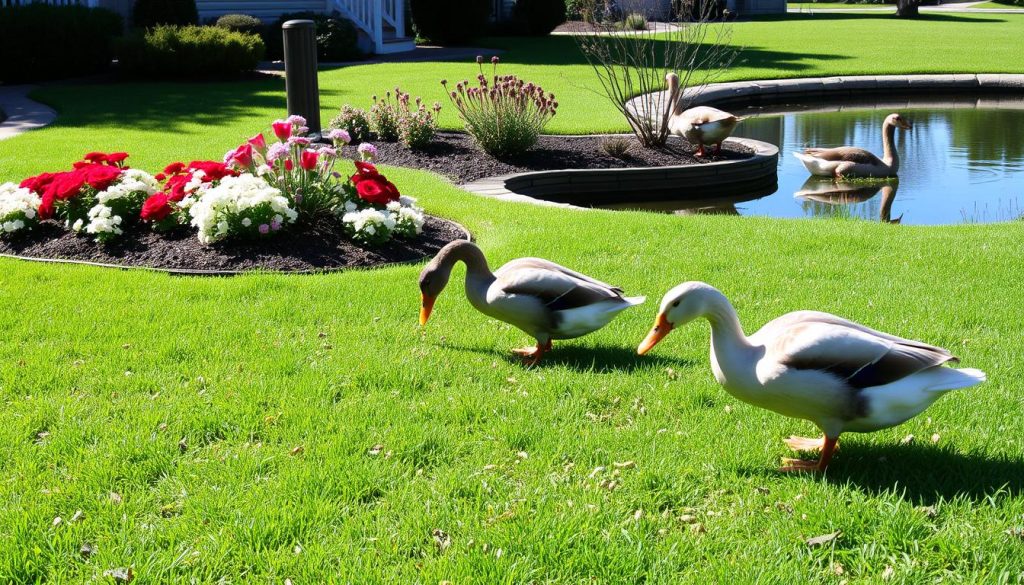
An article on keeping ducks from destroying yards got 920 shares. This shows how important duck control methods are for protecting our outdoor spaces. Ducks can be cute, but they can damage yards and gardens.
They leave droppings and create mud pits. We’ll explore duck deterrent techniques and effective duck deterrents to help you reclaim your yard. These methods will help you enjoy a peaceful, duck-free environment.
Ducks are drawn to water sources like ponds and swimming pools in our yards. They can help control insects, but their presence can become a problem. By using the right duck repellents, we can balance wildlife appreciation with yard maintenance.
We’ll guide you through humane duck removal techniques. These include removing food sources, keeping yards clean, and using visual deterrents. We’ll also cover physical barriers and motion-activated devices.
Our goal is to help you prevent and discourage duck infestations. You’ll learn how to protect your yard while caring for the ducks’ well-being. Let’s explore effective ways to get rid of ducks in your yard.
Understanding Duck Behavior and Attractants
Ducks love yards with water sources like ponds, pools, or lakes. These spots offer rest after swimming and insects for food. Understanding duck habits helps us manage their presence better.

Why Ducks are Attracted to Yards
Ducks gravitate to properties with water features. They enjoy landing on water and resting on nearby land. The areas around water often house insects, a key part of their diet.
Common Duck Species Found in Yards
Several duck species often visit residential yards. Each has its own traits and behaviors. Here are some common ones:
- Mallards: Known for their iconic green heads and white-ringed necks, mallards are adaptable and frequently spotted in urban and suburban settings.
- Wood Ducks: These colorful ducks are attracted to wooded areas near water and often nest in tree cavities or nest boxes.
- Muscovy Ducks: Originally from Central and South America, Muscovy ducks have become popular in many regions due to their distinctive appearance and relatively calm demeanor.
Potential Risks and Damages Caused by Ducks
Ducks may seem harmless, but they can cause problems in yards. Their presence can lead to various issues and potential hazards.
- Health Risks: Duck droppings can harbor bacteria and parasites that pose health risks to humans and pets when left uncleaned in yards.
- Property Damage: Ducks can trample and eat vegetation, dig holes in lawns, and create unsightly messes with their droppings.
- Aggressive Behavior: Ducks, particularly males during mating season, can display aggressive behavior towards humans and other animals.
| Predator | Threat Level | Description |
|---|---|---|
| Dogs | High | Larger dog breeds can cause severe harm or kill ducks. |
| Foxes | Moderate | Clever and stealthy, often sneaking into duck enclosures at night. |
| Coyotes | High | Adaptable predators that target ducks when other food is scarce. |
| Wolves | High | Large and strong, capable of killing ducks with a single bite. |
The majority of duck aggression cases are caused by drakes asserting dominance over humans, with female ducks sometimes becoming targets of aggression from males seeking to mate.
Knowing what draws ducks to our yards helps us manage them better. We can take steps to create a safer outdoor space for everyone.
How to Get Rid of Ducks in Your Yard
Ducks in your yard can be a nuisance. A multi-faceted approach is key to removing them humanely. Let’s explore effective strategies to create an unwelcoming environment for ducks.
Removing Food Sources and Maintaining Cleanliness
Ducks are drawn to yards with food sources. Keep your yard clean by removing fallen fruit, nuts, and berries. Avoid leaving pet food outdoors and secure trash bins.
Store bins in a garage or shed if possible. A tidy yard is less appealing to ducks and discourages their visits.
Using Visual Deterrents and Decoys
Visual deterrents can scare ducks away from your yard. Use predator decoys like coyotes, foxes, or swans to create a threatening presence. For pools, try inflatable animals to simulate predators in the water.
Reposition decoys periodically to maintain their effectiveness. This prevents ducks from getting used to their presence.
Implementing Physical Barriers and Fencing
Physical barriers can restrict duck access to your yard. Install a fence at least 6 feet tall around your property. For ponds or pools, cover the surface with chicken wire or bird netting.
Use temporary fencing to protect specific areas like garden beds. These measures help prevent ducks from entering and settling in your yard.
Utilizing Motion-Activated Sprinklers and Sonic Devices
Motion-activated sprinklers and sonic devices startle ducks with unexpected stimuli. They spray water or emit high-frequency sounds when motion is detected. Place sprinklers strategically in your yard, garden, or orchard.
Position sonic devices near water sources or duck gathering spots. These unpredictable deterrents effectively discourage ducks from returning to your property.
Employing Natural Predator Decoys and Kites
Natural predator decoys and duck repellent kites can frighten ducks away. Place swan decoys in ponds to mimic territorial birds. Attach hawk or owl decoys to trees, roofs, or poles.
Install duck repellent kites on adjustable poles near water sources. These kites resemble predatory birds, intimidating ducks and discouraging visits.
| Duck Deterrent Method | Effectiveness | Maintenance |
|---|---|---|
| Removing Food Sources | High | Regular yard cleaning |
| Visual Decoys | Moderate | Periodic repositioning |
| Physical Barriers and Fencing | High | Initial installation, occasional repairs |
| Motion-Activated Sprinklers | High | Regular maintenance and adjustment |
| Sonic Devices | Moderate to High | Battery replacement, occasional relocation |
| Natural Predator Decoys | Moderate | Periodic repositioning |
| Duck Repellent Kites | Moderate to High | Proper installation, occasional adjustments |
Conclusion
Dealing with ducks in your yard can be challenging. Use effective deterrents and humane removal methods to keep waterfowl away. Remove food sources, maintain cleanliness, and use visual deterrents to discourage ducks.
Physical barriers and motion-activated devices can also help. Combine these techniques and adapt your approach as needed. This will prevent duck infestations and maintain a peaceful, duck-free environment.
Remember, ducks are wildlife and deserve humane treatment. Focus on deterrence rather than harmful methods. This promotes a harmonious relationship between humans and wildlife.
Understanding duck behavior is key to managing populations. Eliminate attractants and implement effective deterrents to reclaim your outdoor space. With a proactive approach, you can keep ducks away and enjoy your yard.







